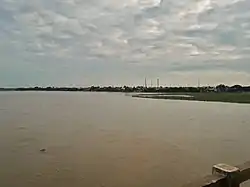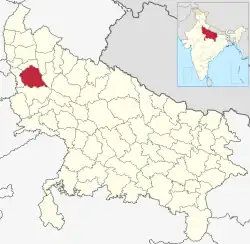Bulandshahr district
Bulandshahr district (also spelled Bulandshahar) is a district in the Meerut region in the North Indian state of Uttar Pradesh (UP), situated between the two rivers Ganga and Yamuna.[3] It is a part of the National Capital Region of India, and Bulandshahr is the district headquarters.[4]
Bulandshahr district | |
|---|---|
 | |
 Location of Bulandshahr district in Uttar Pradesh | |
| Country | |
| State | Uttar Pradesh |
| Division | Meerut |
| Headquarters | Bulandshahr |
| Tehsils | Bulandshahr, Syana, Anoopshahr, Shikarpur, Khurja, dibai, Sikandrabad |
| Government | |
| • Lok Sabha constituencies | Bulandshahr |
| Area | |
| • Total | 4,441 km2 (1,715 sq mi) |
| Population (2011)[1] | |
| • Total | 3,499,171 |
| • Density | 790/km2 (2,000/sq mi) |
| Demographics | |
| • Literacy | 75.23 per cent[2] |
| • Sex ratio | 892 |
| Time zone | UTC+05:30 (IST) |
| Major highways | National Highway 91 |
| Website | bulandshahar |
The district is situated between 28.4° south and 28.0° north latitudes and between 77.0° and 78.0° east longitudes.[5][3] It is bordered by Hapur district to the north, Amroha and Sambhal districts to the east, Aligarh district to the south and Gautam Buddha Nagar district to the west.[3]
Demographics
According to the 2011 census, Bulandshahr district had a population of 3,499,171,[1] roughly equal to the nation of Lithuania[7] or the US state of Connecticut.[8] This makes it the 85th most populous district of the total 640.[1] The district has a population density of 788 inhabitants per square kilometre (2,040/sq mi).[1]
Its population growth rate over the decade 2001-2011 was 20.09%.[1] Bulandshahar has a sex ratio of 892 females for every 1000 males,[1] and a literacy rate of 76.23%. Scheduled Castes make up 20.74% of the population.[1]
In 1901, the population stood at 1,138,101.[9]
At the time of the 2011 Census of India, 93.23% of the population in the district spoke Hindi and 6.58% Urdu as their first language.[10]
| Year | Pop. | ±% p.a. |
|---|---|---|
| 1901 | 939,586 | — |
| 1911 | 927,761 | −0.13% |
| 1921 | 881,448 | −0.51% |
| 1931 | 939,944 | +0.64% |
| 1941 | 1,089,311 | +1.49% |
| 1951 | 1,241,139 | +1.31% |
| 1961 | 1,427,433 | +1.41% |
| 1971 | 1,690,092 | +1.70% |
| 1981 | 2,110,285 | +2.25% |
| 1991 | 2,547,750 | +1.90% |
| 2001 | 3,009,860 | +1.68% |
| 2011 | 3,499,171 | +1.52% |
| source:[11] | ||
Agriculture
The district of Bulandshahar is an important grain producing agricultural district. Wheat, potatoes, maize, sugar and many others are cultivated here in large quantities.[12][13]
References
- "District Census 2011". Census2011.co.in. 2011. Retrieved 30 September 2011.
- "District-specific Literates and Literacy Rates, 2001". Registrar General, India, Ministry of Home Affairs. Retrieved 10 October 2010.
- "District-Profile | District Bulandshahr, Government of Uttar Pradesh | India". Archived from the original on 19 January 2021. Retrieved 17 April 2021.
- "National Capital Region Planning Board". ncrpb.nic.in. Archived from the original on 7 May 2015. Retrieved 10 November 2017.
- "Bulandshahar District Map". www.mapsofindia.com. Retrieved 21 November 2017.
- "Table C-01 Population by Religion: Uttar Pradesh". censusindia.gov.in. Registrar General and Census Commissioner of India. 2011.
- US Directorate of Intelligence. "Country Comparison:Population". Archived from the original on 27 September 2011. Retrieved 1 October 2011.
Lithuania 3,535,547 July 2011 est.
- "2010 Resident Population Data". U. S. Census Bureau. Archived from the original on 1 January 2011. Retrieved 30 September 2011.
Connecticut 3,574,097
- Chisholm, Hugh, ed. (1911). . Encyclopædia Britannica. Vol. 4 (11th ed.). Cambridge University Press. p. 771.
- "Table C-16 Population by Mother Tongue: Uttar Pradesh". www.censusindia.gov.in. Registrar General and Census Commissioner of India.
- Decadal Variation In Population Since 1901
- "Bulandshahr Agriculture, District Level Information of Bulandshahr | Uttar Pradesh". www.districtsofindia.com. Retrieved 21 November 2017.
- "Agricultural Efficiency in Uttar Pradesh" (PDF).